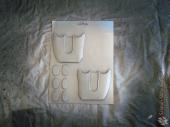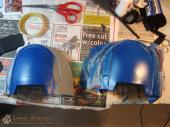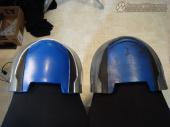Painting Garrus' Armor
Sarrah Wilkinson - 9/22/2013
This is one of a series of blogs about how I made my Garrus costume. View everything related to this cosplay here!
We're almost to the end! The last post, Other Garrus Armor Pieces, talked about foam armor building. This one shows how I went about sealing, priming, painting, and detailing all of the armor pieces.
Foam armor is amazing stuff, but painting it is not a quick process! If you try to paint it without sealing it first, the paint will just soak right in and you will not be able to get the effect you want. I also recommend a primer before painting, but I'll get into that more below.
Ways to seal foam:
- Mod Podge - This a decoupage glue - really, kind of a combination glue, finish, and sealant. This is what I ended up using for my entire armor suit. It only took 3 coats to seal the foam and, because it brushes on, gave a distinctive brushed metal appearance to the final texture. That's not desirable on all armors, of course, but it looked fantastic for Garrus!
- White glue - This tutorial shows how to use watered-down white glue to seal a piece of foam armor. The advantage, of course, is that white glue is cheap and readily available pretty much everywhere! The disadvantage is that it takes several coats (that tutorial recommends 7-8) and a long time! I started by using white glue for my armor, but wasn't satisfied with it. I will also note it does not react well with the awful yoga mat foam I used on part of Garrus' carapace.
- Plasti Dip - I have not used this stuff (yet!), but I've heard great things about it. Plasti Dip is a synthetic rubber coating that many people have successfully used as a sealant for foam armors. It comes in both brush-able and spray-able form. The downside is that it is pricier than the other options.
- Epsilon - This is a rather unique product, a material made specifically as a foam sealer. I've only seen one person use it yet - Alyssa of Propped Up Creations on her amazing Judoon costume - and she seemed quite positive about it. It is on my list to try at some point.
 |
Because I used Mod Podge, that's what I'll focus on here! You can buy Mod Podge online, or you can find it at most U.S. based craft stores. For reference, I did my entire Garrus costume using one 16 oz. bottle, and I still had a little left over. This stuff goes a long way. |
Here are two of the armor pieces, a foot and the carapace, being coated with Mod Podge. It's wet in these pictures and has a white appearance, but it dries nice and clear. It is fairly thick stuff and, depending on how you paint it on, the brush strokes can be quite evident. In my case, I actually wanted that, to simulate a brushed metal texture and appearance. It can also be used to hide small flaws in the foam build, and can be sanded once it's dry if need be.
Each armor piece got 3 coats of Mod Podge, which was allowed to dry a few hours between coats. I also used pieces of masking tape to cover the plastic film where the lights would eventually be.
Here's my setup for doing the spray painting. I used a cheap plastic party tablecloth for my drop cloth, with rocks on all four corners as a precaution in case of wind. I was doing this in my garage with the door open a few feet. It can get pretty windy here!
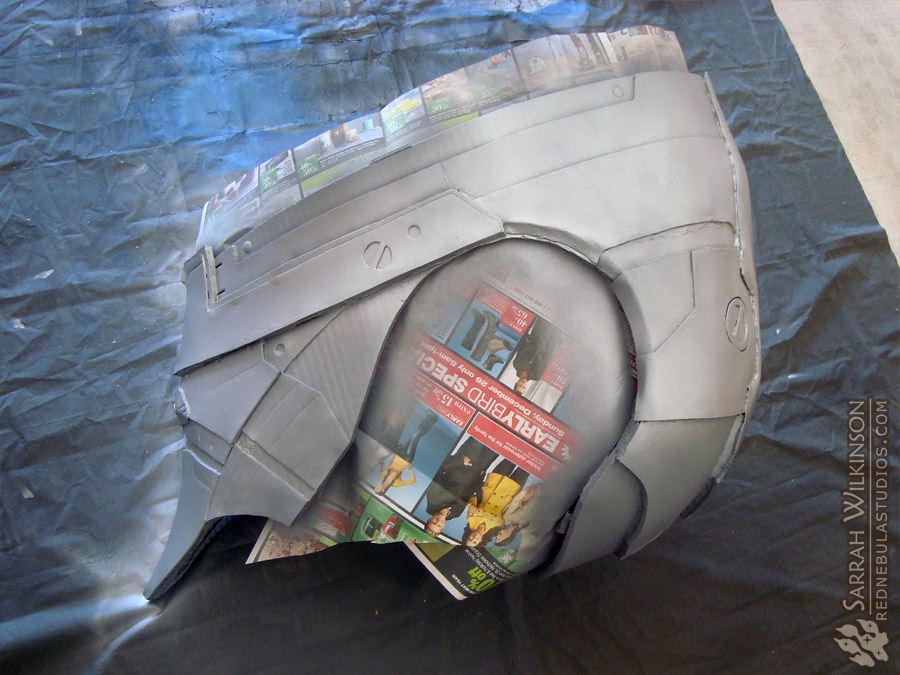
Painting the armor took several steps. The initial painting was done using spray paint, which meant I needed to carefully mask off areas I didn't want getting paint on them. As you can see in this picture, I used pieces of newspaper (attached with masking tape) to shield where I didn't want paint to go.
The first layer of spray paint was a primer, to give a solid base color (the foam colors would've shown through a little if I had just used spray paint). The same spray paint will also look slightly different if painted over grey primer or over black primer, something else to keep in mind. I used that to my advantage to create some nice variations in the tones of his silver ME3 armor!
Here are the feet, the bracers, and part of the thigh armor getting their base coats of spray paint. Again, notice the masking on the inside of the shoes and on parts of the thigh armor.
To keep the small armor pieces for the hands from blowing away while I tried to spray paint them, I used masking tape to attach them to cardboard or PVC pipe. These pieces will later be attached to cloth 3-fingered gloves, but it was much easier to paint them before attaching them.
Many pieces of armor had multiple, distinctive base colors, especially the blue or black sections. Here, you can see how I masked off the armor to paint the base coats for several different colored areas.
Now for the really fun part - detailing! The first photo really shows the difference. The shoulder piece on the left could've just come off the showroom floor, but the weathered one on the right has seen some action! The other pictures show part of the thigh armor, the hand armor pieces, and the bracers after receiving their detailing paint.
Now, pardon if I shout, but...
Detailing is one of those steps that often gets neglected, but it can really make the difference between a good costume and a great one!
Ahem. Sorry. :)
The process I used is pretty simple, and this is pretty much what I did on every piece:
- Start with a mix of 1 part black acrylic paint and 1 part water.
- Use a chip brush to apply this mix over the armor piece.
- Use a paper towel to LIGHTLY wipe away some of the paint. If you're going for the brushed metal look, run the paper towel in the same direction as the "grain" of the metal. Let the dark paint remain in the crevices.
- Repeat step 3 until you're satisfied with the look.
- Use a smaller paintbrush and undiluted black paint to further enhance crevice areas, and add a bit of "battle damage" if you wish.
- Use a small paintbrush and undiluted silver paint to highlight edges and corners. If need be, mix in a smidge of white paint to really bump up the contrast.
Hint: As with the mask, the more detail you put in at this point, the better your costume is going to look in photographs. Remember that a flash washes out quite a bit of detail! This will make up for it.
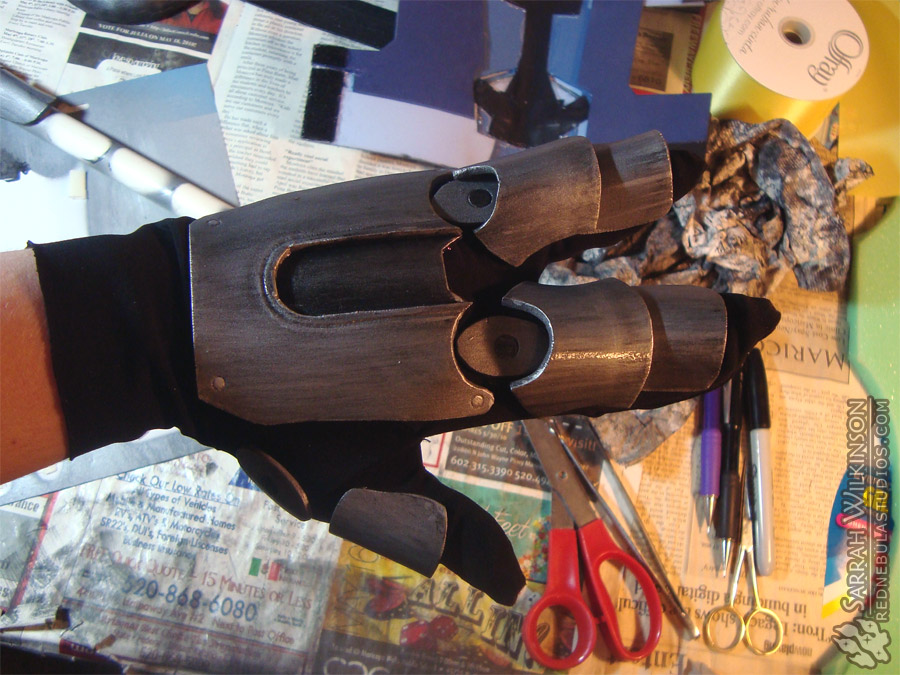
Here's one of the finished hands, where you can easily see the last step of the painting process. Before attaching the armor pieces to the glove with hot glue, I went over them with a few layers of spray sealer - specifically, the glossy variety of Krylon Crystal Clear. It gives the final armor a lovely sheen, and seals it nicely to help protect it from chips and nicks.

So, here's the (almost!) finished armor set all put together! This was a moment of truth for me, because it was the first time I'd tried everything on at once. I was super excited seeing it all come together like this!
There are a few things missing at this point. The last picture shows me holding on the outer piece of thigh armor. Because there are lights in that piece, I had to wire them up first and attach the piece afterward. There are also a couple of small armor bits missing, but overall, it was good enough that I was ready to take him to PHXCC.
You can see the finished cosplay here!
Categories: Costuming
Tags: armor, cosplay, costume, detailing, Garrus, Mass Effect, Mod Podge, painting, priming, sealing, turian, Vakarian
Live Date: 9/22/2013 |
Last Modified: 9/22/2013






